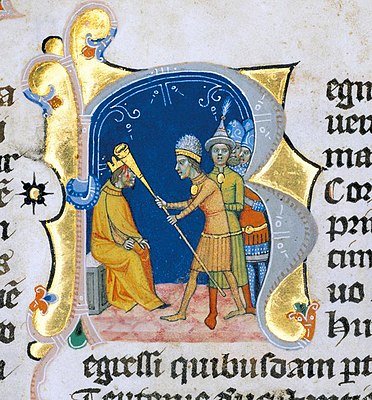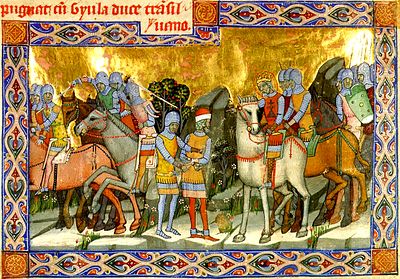This is an old revision of this page, as edited by OrionNimrod (talk | contribs) at 19:38, 1 January 2022. The present address (URL) is a permanent link to this revision, which may differ significantly from the current revision.
Revision as of 19:38, 1 January 2022 by OrionNimrod (talk | contribs)(diff) ← Previous revision | Latest revision (diff) | Newer revision → (diff) Misplaced Pages list article
This is a list of military conflicts in which Hungarian armed forces participated in or took place on the historical territory of Hungary.
The list gives the name, the date, the Hungarian allies and enemies, and the result of these conflicts following this legend:
- Victory
- Defeat
- Another result (e.g. a treaty or peace without a clear result, status quo ante bellum, result of civil or internal conflict, result unknown or indecisive)
- Ongoing conflict
Middle Ages
Wars under the Árpád-Dynasty's rule
| Date | Conflict | Allies | Enemies | Result |
|---|---|---|---|---|
| ~800–970 | Hungarian invasions of Europe |
Kingdom of Italy West Francia Middle Francia Great Moravia Al-Andalus Principality of Serbia |
More than a century of raids and decisive wars
| |
| 811 | Battle of Pliska | Hungarian Tribes |
Decisive Bulgarian victory
| |
| ~830 | Hungarian – Khazar War | Hungarian Tribes | Khazars | Hungarian victory |
| 894 | Byzantine – Bulgarian War | |||
| 895 | Campaign of Kiev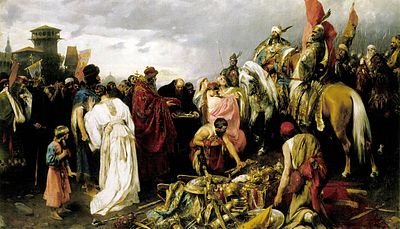 |
Hungarian victory | ||
| ~895–902 | Hungarian conquest of the Carpathian Basin |
Great Moravia |
Hungarian conquest of the Carpathian Basin | |
| 899 | Battle of Brenta |
Kingdom of Italy | Hungarian victory
| |
| 901 | Carinthian campaign
|
Duchy of Carinthia |
Hungarian victory | |
| 907 | Battle of Pressburg / Pozsony
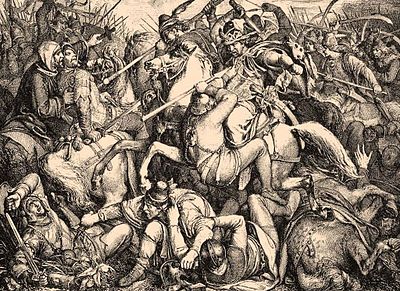 |
Decisive Hungarian victory
| ||
| 908 | Battle of Eisenach |
Hungarian victory
| ||
| 910 | Battle of Lechfeld / Augsburg | Swabia |
Hungarian victory | |
| 910 | Battle of Rednitz | Duchy of Franconia Duchy of Lotharingia |
Hungarian victory | |
| 917 | Battle of Achelous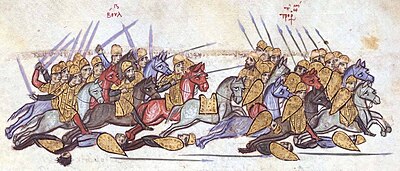 |
Pechenegs |
Bulgarian victory
| |
| 919 | Battle of Püchen | Hungarian victory | ||
| 933 | Battle of Merseburg / Riade |
German victory | ||
| 934 | Battle of W.l.n.d.r | Pechenegs Muslim auxiliary troops |
Muslims converted to Christianity |
Decisive Hungarian-Pecheneg victory |
| 942 | Battle of Fraxinet | Muslims | Hungarian victory | |
| 955 | Battle of Lechfeld / Augsburg |
Duchy of Thuringia Duchy of Swabia |
Hungarian defeat
| |
| 960 | Battle of Drina | Principality of Serbia | Serbian victory
| |
| 960 | Battle of Syrmia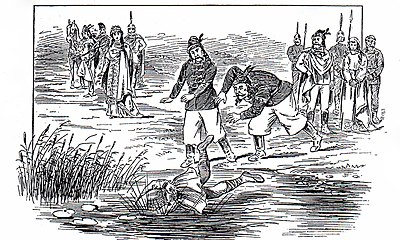 |
Principality of Serbia | Hungarian victory
| |
| 970 | Battle of Arcadiopolis | Pechenegs |
Byzantine victory
| |
| 984 | Hungarian – German border conflict at Melk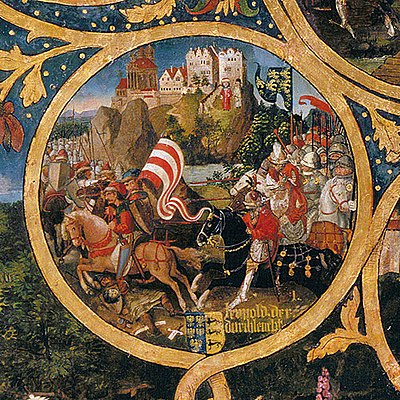 |
Hungarian defeat
| ||
| 997 | Koppány's revolt |
Koppány's Army | Koppány's defeat | |
| 1003 | King Stephen I's military campaign against Gyula of Transylvania |
Gyula III of Transylvania | Successful campaign of King Saint Stephen of Hungary
| |
| 1008 (?),
1029 (?) |
King Stephen I's military campaign against Ajtony, a tribal leader in the Banat | Ajtony's Army | Successful campaign, Ajtony's defeat | |
| 1017–1018 | Hungarian – Polish war | Stalemate | ||
| ~1018 | Pecheneg attack against Hungary | Pecheneg tribes | Hungarian victory | |
| 1018 | Hungarian – Bulgarian War | Hungarian-Byzantine victory | ||
| 1018 | The intervention of Boleslaw the Brave, Duke of Poland in the Kievan succession crisis | Pechenegs |
Temporary victory for Sviatopolk and Bolesław, Polish sack of Kiev | |
| 1030–1031 | Emperor Conrad II's military campaign against Hungary | Hungarian victory
| ||
| 1041 | Uprising against King Peter Orseolo | Hungarian nobles | Suppression of King Peter | |
| 1042–1043 | German – Hungarian wars | Hungarian defeat | ||
| 1044 | Henry III's military campaign against Hungary
|
Peter Orseolo and his allies |
Defeat of Samuel Aba, restoration of Peter | |
| 1046 | War between King Peter and Prince Andrew | Hungarian victory | ||
| 1046 | Vata pagan uprising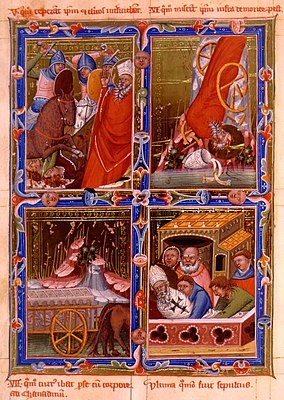 |
Paganic rebels | Prince Andrew's victory
| |
1051–1052
|
Emperor Henry III's military campaigns against Hungary
|
Hungarian victory | ||
| 1056–1058 | German – Hungarian border war | Stalemate, treaty of Marchfeld | ||
| 1060 | Civil war between King Andrew I and his brother, Prince Béla
|
Prince Béla's victory | ||
| 1061 | Second paganic uprising | Paganic rebels | Uprising suppressed | |
| 1067 | Croatian campaign | Duchy of Carinthia | Hungarian victory
| |
| 1068 | Hungarian – Bohemian war | King Solomon of Hungary occupies Bohemia | ||
| 1068 | Pecheneg attack against Hungary
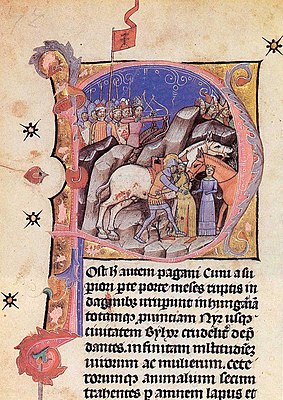 |
Pechenegs Ouzes |
Hungarian victory | |
| 1071–1072 | Hungarian – Byzantine war |
Pechenegs |
Hungarian victory
| |
| 1074 | Civil war between King Solomon and his cousins Géza and Ladislaus
|
Prince Géza and Ladislaus defeat the armies of King Solomon and Emperor Henry IV. King Solomon was dethroned. | ||
| 1075 | Henry IV's military campaign against Hungary | Solomon's army |
Hungarian victory | |
| 1079 | Henry IV's military campaign against King Saint Ladislaus | Hungarian victory | ||
| 1085 | Pecheneg invasion of Hungary | Pecheneg tribes Solomon's army |
Hungarian victory | |
| 1091 | Pecheneg attack against Hungary | Pecheneg tribes | Hungarian victory | |
| 1091 | Hungarian occupation of Croatia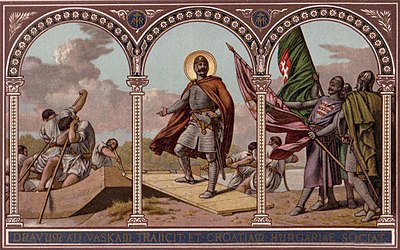 |
Hungarian victory
| ||
| 1092 | Ruthenian campaign by King Saint Ladislaus | Hungarian victory | ||
| 1094 | King Ladislaus I's intervention in a conflict between Władysław I Herman, Duke of Poland, and the duke's illegitimate son, Zbigniew. | Hungarian victory | ||
1093–1097
|
Petar Svačić's Croatian uprising against the Hungarian rule
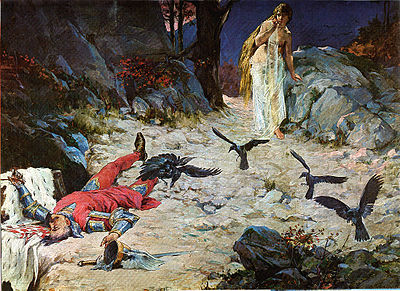 |
Decisive Hungarian victory
| ||
| 1095 | Campaign in Apulia | Hungarian victory
| ||
| 1096 | King Coloman's defensive operations against the different armies of the crusaders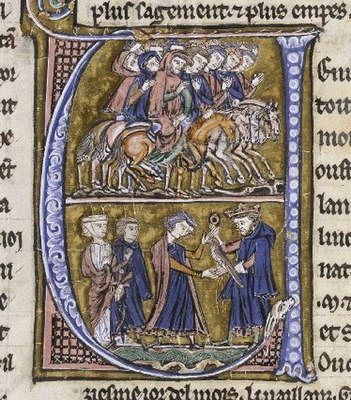 |
Hungarian victories | ||
| 1098–1099 | King Coloman's war against the Kievan Rus' | Davyd Ihorevych's army |
Mstyslav Sviatopolkovych's army Pecheneg tribes |
Hungarian defeat |
| 1105 | Siege of Zara and occupation of Dalmatia | Dalmatian cities |
Hungarian victory | |
| 1107 | Campaign in Apulia | Hungarian victory
| ||
| 1108 | Hungarian war with the Holy Roman Empire | Hungarian victory | ||
| 1115–1119 | Hungarian – Venetian wars | Hungarian defeat | ||
| 1123 | Stephen II's intervention in the Kievan Rus' internal conflict | Iaroslav from Vladimir |
Hungarian retreat | |
| 1124–1125 | Hungarian – Venetian war | Hungarian defeat | ||
| 1127–1129 | Byzantine-Hungarian War (1127–29) | Grand Principality of Serbia |
Stalemate, peace agreement | |
| 1132 | Hungarian – Polish war | Hungarian victory | ||
| 1136–1137 | Béla II's balcanic campaigns (against Venice and the Byzantine Empire) | Hungarian victory | ||
| 1146 | Battle of the Fischa | Hungarian victory | ||
| 1149–1152 | Géza II's intervention in the conflict between the Principality of Halych and Kievan Rus' | Kievan Rus' |
Peace agreement | |
| 1148–1155 | Hungarian – Byzantine wars | Grand Principality of Serbia |
Ceasefire | |
| 1162–1165 | Hungarian civil war between Stephen III and his uncles Ladislaus and Stephen | Ladislaus and Stephen's army | Stephen III's victory | |
| 1167 | Battle of Sirmium | Banate of Bosnia |
Serbian Grand Principality |
Decisive Byzantine victory, Hungary lost Dalmatia |
| 1168 | Hungarian – Bohemian war | Hungarian victory | ||
| 1176 | Battle of Myriokephalon | Grand Principality of Serbia |
Sultanate of Rum | Seljuk victory
|
| 1180–1184 | Hungarian – Byzantine war | Hungarian victory, Hungary reoccupied Dalmatia | ||
| 1188–1189 | King Béla III's military campaign against Halych | Hungarian victory, occupation of Halych | ||
| 1190 | Battle of Iconium | Sultanate of Rum | Crusader victory
| |
| 1197–1199 | Civil war between King Emeric and his brother Andrew | Emeric's victory | ||
| 1201–1205 | Emeric's balcanic wars | Grand Principality of Serbia Bosnia |
Hungarian victories | |
| 1202 | Siege of Zara |
Hungarian defeat | ||
| 1213–1214, 1219,
1233–1234 |
King Andrew II's military campaigns against Halych | Hungarian retreat | ||
| 1217–1218 | King Andrew II's participation in the Fifth crusade
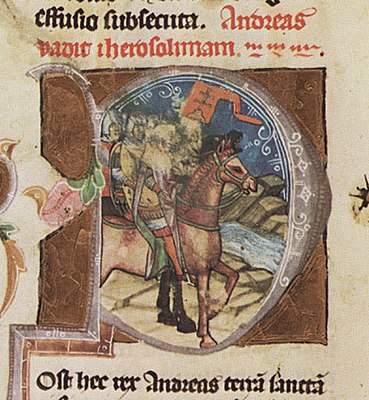 |
Hungarian victories on the battlefields. Muslim forces retreated to their fortresses and towns. | ||
| 1225 | King Andrew II expels the Teutonic Knights from Transylvania, the order had to move to Poland | Hungarian victory | ||
| 1237–1241 | Bosnian Crusade The Hungarian successes were followed by quick Hungarian retreat because of the Mongol invasion of Hungary | "Heretics" within the Banate of Bosnia | Stalemate after the quick Hungarian retreat due to the Mongol attacks | |
| 1241 | Battle of Mohi | Mongols | Hungarian defeat | |
| 1241–1242 | First Mongol invasion of Hungary | Mongols | Mongol victory at the Battle of Mohi. Mongols retreated within a year from Hungary due to the local Hungarian withstand. Both sides suffered a heavy casualties. | |
| 1242 | Battle of Grobnik Field | Mongols | Hungarian-Croatian victory | |
| 1242 | King Béla IV's punishing campaign against Frederick II, Duke of Austria | Hungarian victory | ||
| 1243 | Siege of Zara | Hungarian defeat | ||
| 1246 | Battle of the Leitha River | Hungarian victory | ||
| 1250–1278 | Hungarian – Bohemian wars | Bohemian defeat | ||
| 1259 | Battle of Pelagonia | Empire of Nicaea Cuman cavalry Hungarian mounted archers Turkish cavalry Serbian horsemen German knights |
Triarchy of Negroponte |
Decisive Nicaean victory |
| 1261–1262 | Occupation of Konstantin Tih's Bulgarian Empire by King Béla IV. | Hungarian victory | ||
| 1264–1265 | Internal conflict between King Béla IV and his son, Stephen | Stephen's victory, he got eastern Hungary as a duchy | ||
| 1268 | Mačva War Béla IV 's army captures Stefan Uroš I. Their conflict was solved with dynastic marriage. | Béla IV of Hungary | Hungarian victory | |
| 1272–1279 | Feudal anarchy | Csák noble family |
Kőszegi noble family Gutkeled noble family |
Royal victory |
| 1277 | Stefan Dragutin-Stefan Uroš I conflict | Stefan Dragutin |
Stefan Dragutin | |
| 1277 | Hungary's war with Litovoi in Cumania | Litovoi's army | Hungarian victory | |
| 1278 | Battle on the Marchfeld, at Dürnkrut and Jedenspeigen took place on 26 August 1278 and was a decisive event for the history of Central Europe for the following centuries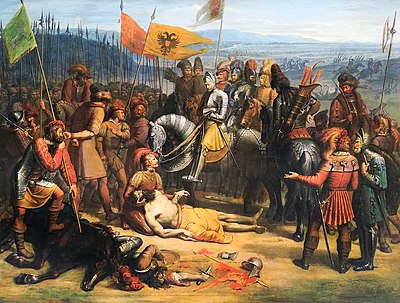 |
Kingdom of Germany Burgraviate of Nuremberg |
Duchy of Głogów Duchy of Lower Bavaria Duchy of Silesia |
German-Hungarian victory
|
| 1282 | Cumanic uprising
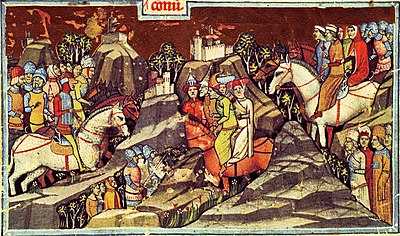 |
Cumanic tribes | Hungarian victory | |
| 1285–1286 | Second Mongol invasion of Hungary |
Decisive Hungarian victory | ||
| 1291 | German – Hungarian war | Hungarian victory | ||
| 1292–1300 | King Andrew III's war with the Kőszegi Hungarian noble family | Kőszegi family | Andrew III's victory | |
| 1298 | Battle of Göllheim | County of Nassau Electoral Palatinate |
Habsburg victory |
Wars between 1301 and 1526
| Date | Conflict | Allies | Enemies | Result |
|---|---|---|---|---|
| 1301–1308 | Hungarian interregnum, fightings for the country's throne | Matthew III Csák's army László Kán's army |
Kőszegi Hungarian noble family |
Charles became Hungarian king |
| 1310–1321 | King Charles I's wars for the centralized power against the Hungarian aristocracy | Matthew III Csák Aba dynasty Borsa family Apor family Kőszegi family |
Royal victory, centralization of the Hungarian Kingdom | |
| 1312 | Battle of Rozgony |
Zipser Saxons |
Aba dynasty Matthew III Csák |
Decisive victory of King Charles I, weakening of the magnates |
| 1319 | Belgrade and Banate of Mačva | Charles I | ||
| 1322–1337 | Hungarian–Austrian War, restoration of the western borders, defeat of Austria, Kőszegi and Babonić families | Kőszegi family Babonić Croatian noble family |
Hungarian victory | |
| 1321–1324 | Hungarian–Serbian War | Bosnia Stephen Vladislav II of Syrmia |
Hungarian defeat | |
| 1330 | Battle of Posada |
Hungarian defeat | ||
| 1344 | King Louis the Great's invasion and occupation of Wallachia and Moldavia | Hungarian victory, Wallachia and Moldavia became vassal states of King Louis the Great | ||
| 1345–1358 | Hungarian–Venetian War, Venice had to pay annual tribute to Louis. Venetians also had to raise the Angevin flag on Piazza San Marco. | Decisive Hungarian victory Treaty of Zadar | ||
| 1345 | Hungary's war with the Golden Horde | Hungarian victory | ||
| 1347–1349, 1350–1352 | Hungarian-Naples Wars | First campaign: temporary Hungarian victory Second campaign: status quo ante bellum | ||
| 1348 | Battle of Capua | Hungarian victory, occupation of the kingdom | ||
| 1360–1369 | Louis I's balcanic wars (against Serbia, Bulgaria, Wallachia and Bosnia) |  Second Bulgarian Empire Second Bulgarian Empire Bosnia |
Temporary Hungarian victories | |
| 1366–1367 | Hungarian–Ottoman War | File:Wappen Padua.png Padova |
Christian victory | |
| 1369 | Wallachian campaign | Hungarian victory | ||
| 1372–1381 | War of Chioggia, Hungary defeated the Venetians in several times, and finally expelled Venetians from Dalmatia, however Genoa, Padoa and Austria lost the War. The war resulted in the Treaty of Turin (1381) | File:Wappen Padua.png Padua |
Hungarian victory, Venice had to pay annual tribute to King of Hungary | |
| 1375–1377 | Hungarian–Ottoman War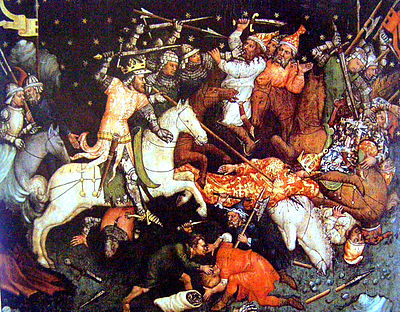 |
Hungarian victory | ||
| 1377 | Hungarian – Lithuanian war | Hungarian victory, Louis I enters Vilnius | ||
| 1384–1394 | Civil war between a part of the Hungarian nobility and Mary, Queen of Hungary and Sigismund king | Horváti family |
Sigismund's victory | |
| 1394–1395 | Wallachian campaign | Wallachia became a Hungarian vassal, Mircea I the Great accepted the lordship of King Sigismund without any fight. | ||
| 1394–1395 | Moldavian campaign | Hungarian victory | ||
| 1396 | Battle of Nicopolis |
Crusader defeat
| ||
| 1407–1408 | Bosnian campaign
|
Hungarian victory
| ||
| 1411–1433 | Hungarian–Venetian War | Dalmatia became part of Venice | ||
| 1415–1419 | Hungarian–Ottoman War | Stalemate | ||
| 1419–1434 | Hussite Wars | Hussites | Eventual defeat for Radical Hussites, victory for Moderate Hussites | |
| 1428–1432 | War of the South Danube | Armistice | ||
| 1437 | Transylvanian peasant revolt of Budai Nagy Antal | Transilvanian peasants | Defeat of the rebels | |
| 1437–1442 | Hungarian–Ottoman border conflicts, Ottoman raids in South-Hungary and Transylvania | Hungarian victory | ||
| 1440 | Siege of Belgrade | Hungarian victory | ||
| 1440–1442 | Civil war between Wladyslaw I and Ladislaus | Hungarian nobles |
Cillei family and other Hungarian nobles | Peace agreement, Wladyslaw is accepted as Hungarian king |
| 1442 | Battle of Hermannstadt / Szeben |
Hungarian victory | ||
| 1442 | Battle near the Iron Gate / Vaskapu | Hungarian victory
| ||
| 1443–1444 | Long campaign | Temporary Hungarian victories. | ||
| 1443 | Battle of Nish | Crusader Victory | ||
| 1443 | Battle of Zlatitsa | Ottoman victory, halting of the advance of the crusaders | ||
| 1444 | Battle of Kunovica | Crusader Victory | ||
| 1444 | Battle of Varna |
Crusader defeat
| ||
| 1447 | Wallachian campaign | Hungarian victory
| ||
| 1448 | Second Battle of Kosovo / Rigómező | Ottoman victory | ||
| 1456 | Siege of Belgrade / Nándorfehérvár
 |
Hungarian victory
| ||
| 1458–1459 | Matthias I's war with Ján Jiskra | Jiskra's soldiers | Royal victory | |
| 1458–1465 | War in Bosnia | A part of Bosnia is occupied by the Ottoman Empire | ||
| 1460 | Battle at Pojejena / Alsópozsgás | Ottoman victory
| ||
| 1464 | Siege of Jajce | Hungarian victory | ||
| 1465–1471 | Hussite uprising in North-Hungary | Czech hussite rebels | Hungarian victory | |
| 1467 | Hungarian - Moldavian war | Moldavian victory | ||
| 1468–1478 | Bohemian War (1468-1478) | Treaty of Olmütz, Matthias became king of Bohemia | ||
| 1471 | Hungarian – Polish war. King Matthias I forced King Casimir IV to withdraw from Hungary | Hungarian victory | ||
| 1471–1476 | Matthias's intervention in the Moldovian – Ottoman War | After initial Hungarian-moldavian victories Hungary stopped the advocating of Moldavia, so Stephen III moldavian ruler became vasal of the Ottoman Empire. | ||
| 1474 | Siege of Wrocław / Breslau / Boroszló | Between 1469 and 1490, Wrocław was part of the Kingdom of Hungary. In 1474, the city was besieged by combined Polish-Czech forces. Kings Casimir IV of Poland, his son Vladislaus II of Bohemia, and Matthias Corvinus of Hungary met in the nearby village, and a ceasefire was signed according to which the city remained under Hungarian rule. | ||
| 1475 | Battle of Vaslui | Moldavian-Hungarian-Polish victory | ||
| 1476 | Siege of Šabac / Szabács | King Matthias besieged and seized Šabac, an important Ottoman border fort | ||
| 1479 | Battle of Breadfield / Kenyérmező |
Hungarian victory over a highly outnumbered Ottoman army in Transylvania. Ottoman casualties were extremely high. The battle was the most significant victory for the Hungarians against the raiding Ottomans, and as a result, the Ottoman Turks did not attack southern Hungary and Transylvania for many years thereafter. | ||
| 1480–1481 | Battle of Otranto | Christian victory | ||
| 1482–1488 | Austrian-Hungarian War (1477-1488) | Decisive Hungarian victory
| ||
| 1485 | Siege of Vienna / Bécs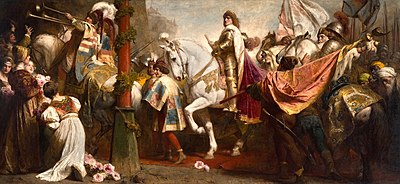 |
Hungarian victory
| ||
| 1486 | Siege of Retz | Hungarian victory | ||
| 1486–1487 | Siege of Wiener Neustadt / Bécsújhely | Hungarian victory
| ||
| 1490–1491 | War of the Hungarian Succession | Treaty | ||
| 1490 | Battle of Csontmező | The supporters of John Corvinus | The supporters of Beatrice of Naples | The supporters of Beatrice of Naples, Stephen Báthory and Paul Kinizsi defeated John Corvinus. |
| 1491–1495 | Hungarian – Ottoman war | Stalemate | ||
| 1492–1493 | The Black Army's uprising | Black Army | Destruction of the Black Army | |
| 1499–1504 | Hungarian – Ottoman war | Stalemate | ||
| 1512–1520 | Hungarian – Ottoman war | Successful defensive operations against the Ottomans | ||
| 1514 | Peasants revolt, led by György Dózsa |
Peasants | Revolt suppressed | |
| 1521 | Siege of Belgrade | Hungarian defeat | ||
| 1526 | Battle of Mohács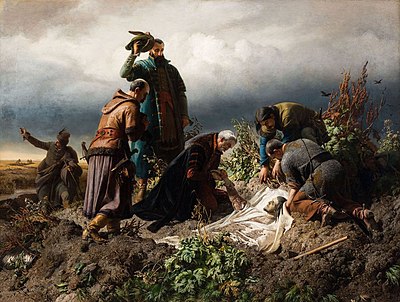 |
Hungarian defeat
|
Wars between 1526 and 1699
| Date | Conflict | Allies | Enemies | Result |
|---|---|---|---|---|
| 1532 | Siege of Kőszeg / Güns |
Hungarian victory
| ||
| 1532 | Battle of Leobersdorf | Habsburg victory
| ||
| 1543 | Siege of Esztergom |
Ottoman victory | ||
| 1552 | Siege of Eger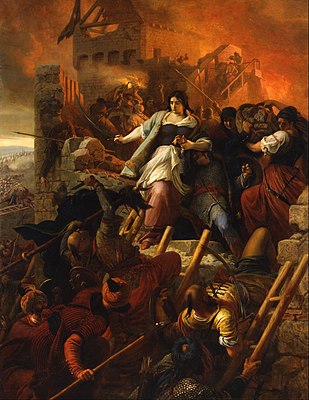 |
Hungarian victory | ||
| 1566 | Siege of Szigetvár
 |
Ottoman victory
| ||
| 1588 | Battle of Szikszó | Hungarian victory | ||
| 1595 | Battle of Călugăreni | Wallachian victory | ||
| 1595 | Battle of Giurgiu / Gyurgyevó | Hungarian victory | ||
| 1596 | Siege of Eger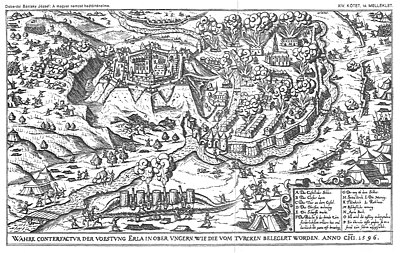 |
Ottoman victory, Ottomans capture Eger | ||
| 1652 | Battle of Vezekény | Hungarian victory | ||
| 1664 | Siege of Léva |
Habsburg-Hungarian victory | ||
| 1686 | Siege of Buda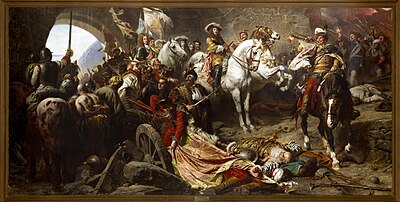 |
Holy League victory
|
- 1526–1538: Hungarian campaign of 1527–1528
- 1526–1527: Jovan Nenad uprising
- 1540–1547: Habsburg–Ottoman war
- 1550–1558: Habsburg–Ottoman war
- 1562: First Székely uprising
- 1565–1568: Habsburg–Ottoman war
- 1572–1573: Croatian–Slovenian peasant revolt
- 1575: Bekes uprising and the second Székely uprising
- 1593–1606: Fifteen Years' war
- 1610–1664: Habsburg–Ottoman border conflicts
- 1596: Third Székely uprising
- 1611–1613: Transylvanian Civil War and Ottoman military intervention
- 1618–1648: Thirty Years' war
- 1632: Peasants revolt, led by Péter Császár (in Transylvania and in the Royal Hungary)
- 1636: Transylvanian – Ottoman war
- 1656–1657: Transylvanian military campaign against Poland
- 1657–1662: Ottoman–Transylvanian war
- 1663–1664: Austro-Turkish War (1663–64)
- (1672) 1678–1685: Thököly uprising
- 1683–1699: Great Turkish War
- 1697: Hegyalja uprising
Wars between 1700 and 1900
| Conflict | Belligerents | Result | |||
|---|---|---|---|---|---|
| Date | Name | Allies | Enemies | Outcome | |
| 15 June 1703 – 1 May 1711 | Rákóczi's War for Independence
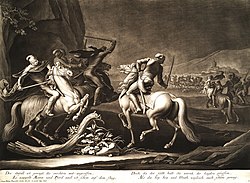 |
|
Defeat
| ||
| January 1716 – 21 July 1718 | Austro-Turkish War (1716–1718)
 |
|
|
Treaty of Passarowitz | |
| 1735 – 1 September 1739 | Russo-Austro-Turkish War | Victory | |||
| 1735–1736 | Peasants' Revolt | Defeat | |||
| 16 December 1740 – 18 October 1748 | War of the Austrian Succession
 |
| |||
| 17 May 1756 – 15 February 1763 | Seven Years' War |
|
|
Status Quo Ante Bellum | |
| 31 October – 14 December 1784 | Revolt of Horea, Cloșca and Crișan | Transylvanian Romanian rebels | Victory | ||
| 20 April 1792 – 18 October 1797 | War of the First Coalition |
|
Defeat | ||
| December 1798 – 25 March 1802 | War of the Second Coalition |
|
Defeat | ||
| April 1805 – 21 July 1806 | War of the Third Coalition |
|
Defeat
| ||
| 10 April – 14 October 1809 | War of the Fifth Coalition
 |
Defeat | |||
| 24 June – 14 December 1812 | French invasion of Russia | The Habsburg Monarchy joins the Coalition
| |||
| 3 March 1813 – 30 May 1814 | War of the Sixth Coalition
 |
Victory | |||
| 20 March – 8 July 1815 | War of the Seventh Coalition |
|
Victory | ||
| July – August 1831 | Cholera Riots | Hungarian peasants | Defeat | ||
| 15 March 1848 – 4 October 1849 | Hungarian Revolution of 1848
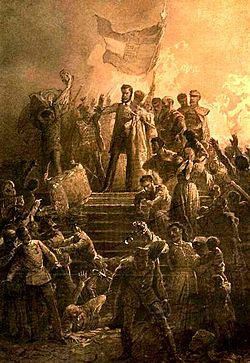 |
Defeat
| |||
| 19 September 1848 – 21 November 1849 | Slovak Uprising of 1848–49 | Indecisive settlement | |||
| 29 April – 11 July 1859 | Second Italian War of Independence
 |
Defeat
| |||
| 14 June – 26 July 1866 | Austro-Prussian War
 |
Defeat
| |||
| October 1869 – 11 January 1870 | Krivošije Uprising | Krivošije rebels | Stalemate
| ||
| 29 July – 20 October 1878 | Occupation of Bosnia | Victory
| |||
| 2 November 1899 – 7 September 1901 | Boxer Rebellion
 |
Eight-Nation Alliance |
Victory
| ||
- In rebellion against Bavaria
Wars in the 20th century
| Conflict | Belligerents | Result | |||
|---|---|---|---|---|---|
| Date | Name | Allies | Enemies | Outcome | |
| 28 July 1914 – 11 November 1918 | World War I
 |
Central Powers |
Allied Powers Co-belligerents |
Defeat
| |
| December 1918 – June 1919 | Hungarian–Czechoslovak War | Military VictoryPolitical Defeat
| |||
| 13 November 1918 – 3 August 1919 | Hungarian–Romanian War
 |
Defeat
| |||
| 3 August – 13 October 1921 | Uprising in West Hungary | (disarmament of the rebels in 1921) |
Victory
| ||
| 23 – 31 March 1939 | Slovak-Hungarian War | Victory
| |||
| 1 September 1939 – 2 September 1945 Hungary entered: 27 June 1941 Hungary exited: 11 May 1945 |
World War II
  |
Axis Powers Affiliate states Client States Co-belligerents Active neutrality |
Allied Powers In exile for part of the war Other important belligerents Co-belligerents
|
Defeat
| |
| 23 October – 10 November 1956 | Hungarian Revolution of 1956
 |
Defeat
| |||
| 20 – 21 August 1968 | Warsaw Pact invasion of Czechoslovakia
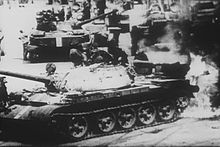 |
Warsaw Pact supported by |
Victory
| ||
Wars in the 21st century
| Conflict | Belligerents | Result | |||
|---|---|---|---|---|---|
| Date | Name | Allies | Enemies | Outcome | Losses |
| March 2003 – 2009 | Iraq War |
|
For fighting between insurgent groups, see Civil war in Iraq (2006–07). |
Victory
|
12 wounded. |
| 7 October 2001 – 30 August 2021 | War in Afghanistan | Taliban Victory / US-allied defeat
|
14 wounded. | ||
See also
References
- ^ Szabados György: Vereség háttér nélkül? Augsburg 955 Hitel 2005.augusztus
- Nagy Kálmán: A honfoglalás korának hadtörténete; Heraldika Kiadó, Budapest, 2007, p. 168
- Király, Péter. Gondolatok a kalandozásokról M. G. Kellner "Ungarneinfälle..." könyve kapcsán .
- Baják László (2000). p. 15
- Kristó Gyula: Levedi törzsszövetségétől Szent István államáig; Magvető Könyvkiadó, Budapest, 1980 p. 248 From Miracula Sancti Georgii. Hungarian translation: "A nyugati népek, azaz a bolgárok, magyarok, szküthák, médek és türkök leghevesebb felkelése történt" English translation from the Hungarian: It was the most violent upraising of the Western nations: the Bulgarians, Hungarians, Scythians, Medians and Turks
- Bóna István (2000). p. 54
- Baják László (2000). p. 30–32
- Bowlus 2016, p. 181. sfn error: no target: CITEREFBowlus2016 (help)
- Bowlus 2016, p. 5. sfn error: no target: CITEREFBowlus2016 (help)
- ^ Bánlaki, József (1928). A magyar nemzet hadtörténelme (in Hungarian). pp. A 984. évi mölki összecsapás.
- Rónai Horváth, Jenő (1895). Magyar hadi krónika - Első rész. - A honfoglalástól a mohácsi vészig (PDF) (in Hungarian). Budapest: Hungarian Academy of Sciences / A Magyar Tudományos Akadémia hadtudományi bizottsága.
- Kosztolnyik, Z. J. (1981). Five Eleventh Century Hungarian Kings: Their Policies and their Relations with Rome. Boulder. p. 82. ISBN 0-914710-73-7.
- Érszegi, Géza; Solymosi, László (1981). "Az Árpádok királysága, 1000–1301" [The Monarchy of the Árpáds, 1000–1301]. In Solymosi, László (ed.). Magyarország történeti kronológiája, I: a kezdetektől 1526-ig [Historical Chronology of Hungary, Volume I: From the Beginning to 1526] (in Hungarian). Akadémiai Kiadó. p. 89. ISBN 963-05-2661-1.
- Bánlaki, József (1928). A magyar nemzet hadtörténelme (in Hungarian). pp. IV. Henrik hadjárata László ellen 1079-ben.
- Bánlaki, József (1928). A magyar nemzet hadtörténelme (in Hungarian). pp. Az 1095. évi horvátországi és apuliai hadjárat.
- Bánlaki, József (1928). A magyar nemzet hadtörténelme (in Hungarian). pp. Az 1107. évi apuliai hadjárat.
- Bierter Band (1821). War and Technology. Heuber. pp. 299–302.
- ^ Obrusánszky, Borbála. A tatárok kivonulásának okai (PDF).
- Oxford University (2010). The Oxford Encyclopedia of Medieval Warfare and Military Technology: Vol. 1. Oxford University Press. p. 33. ISBN 9780195334036.
- Madgearu 2017, p. 248. sfn error: no target: CITEREFMadgearu2017 (help)
- Fine 1994, p. 174. sfn error: no target: CITEREFFine1994 (help)
- Ion Grumeza: The Roots of Balkanization: Eastern Europe C.E. 500–1500, University Press of America, 2010
- Robert Maddock (2016). The 1,300 Years' War: Volume One. Xlibris Corporation. p. 449. ISBN 9781524533762.
- Liviu Pilat; Ovidiu Cristea (2017). The Ottoman Threat and Crusading on the Eastern Border of Christendom During the 15th Century. Brill Publishers. p. 67. ISBN 9789004353800.
- Engel 2001, p. 302.
- Pop 2005, p. 266.
- Lieber (1845), p. 345.
- Dupuy (1970), p. 501.
- Coppée (1864), pp. 562–565.
- Nafziger & Walton (2003), p. 105
- Left the war after signing the Peace of Basel with France.
- Ali, Idrees (15 January 2021). "U.S. troops in Afghanistan now down to 2,500, lowest since 2001: Pentagon". Reuters. Retrieved 26 November 2021.
- Engel, Pál (2001). The Realm of St Stephen: A History of Medieval Hungary, 895–1526. I.B. Tauris Publishers. ISBN 1-86064-061-3.
- Pop, Ioan-Aurel (2005). "The Romanians in the 14th–16th centuries from the "Christian Republic" to the "Restoration of Dacia"". In Pop, Ioan-Aurel; Bolovan, Ioan (eds.). History of Romania: Compendium. Romanian Cultural Institute (Center for Transylvanian Studies). pp. 209–314. ISBN 978-973-7784-12-4.
Sources
- Gyula Kristó; Ferenc Makk (1996). Az Árpád-ház uralkodói (in Hungarian). I.P.C. Könyvek. ISBN 978-963-7930-97-3.
- Magyar Tudományos Akadémia (1987). Magyarország története: Elozmenyek es Magyar tortenet 1242-IG. Akadémiai Kiadó. ISBN 9789630515184.
| Lists of wars involving European countries | |
|---|---|
| Sovereign states |
|
| States with limited recognition | |
| Dependencies and other entities | |
| Armed conflicts involving Hungary | |||||||||||||
|---|---|---|---|---|---|---|---|---|---|---|---|---|---|
| Hungary |
| ||||||||||||
| International |
| ||||||||||||
| Hungary articles | |||||
|---|---|---|---|---|---|
| History |
| ||||
| Geography | |||||
| Politics | |||||
| Economy | |||||
| Society |
| ||||

